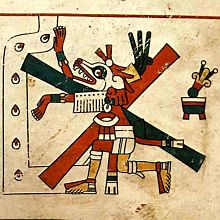Xolotl

Xolotl was the dark twin brother of Quetzalcoatl in the Aztec gods as well as in the Toltec . Xolotl and Quetzalcoatl were the sons of the virgin Coatlicue .
Duties and Appearance
Xolotl or Xōlōtl stands in the Nahuatl language on the one hand for "servant", "page", "fool", "harlequin" or feathers of a certain bird, on the other hand for "monster", "monster".
Xolotl was the god of lightning, death and misfortune. He was the lord of the evening star and thus the dark side of Venus. He was the god of the underworld, the protector of the twins and the keeper of the Aztec ball game ulama . At times he was equated with Xocotl , the lord of the stars and fire. In Mictlan he helped the deceased on their journey through the afterlife, just as he accompanied the sun on its dangerous path through the underworld at night.
Xolotl was often depicted as a skeleton or as a monstrously distorted figure with a dog's head ( xolotl also means "monster" in Nahuatl) and twisted feet. Sometimes he is hunchbacked, and as a sign of destructiveness he carries an ax in his hand and a solar disk on his back.
Name relationships
The name of the axolotl (Nahuatl: axólotl < a-tl + xólo-tl , water monster), a Central American amphibian, is associated with Xolotl in Aztec mythology. When the gods were to be sacrificed to set the fifth sun in motion, Xolotl had hidden to avoid death. At first it turned into an agave plant of the species mexolotl , then into other monstrous things, and finally into an axolotl.
Finally, Xoloitzcuintle (Nahuatl: xóloitzcuintli < xólo-tl + itzcuin-tli , monstrous dog) is the name of a Mexican hairless dog breed. The breed was known even in pre-Columbian times. The affinity of Xolotl's name to the dog breed refers to the mythical idea of the Aztecs that every deceased was accompanied by a dog of this breed on his way through the underworld. Despite the important position of dogs within the spiritual worldview of the Aztecs, many peoples of pre-Hispanic Central America also used their meat as a source of food.
literature
- Heike Owusu: Symbols of the Inca, Maya and Aztecs , Schirner Verlag Darmstadt (2000), ISBN 3-89767-073-9
- Günter Lanczkowski, The Religion of the Aztecs, Maya and Inka , Wissenschaftliche Buchgesellschaft Darmstadt (1989), ISBN 3-534-03222-5
Web links
- Xolotl in the Azteccalendar (English)
- Gods of the Aztecs (English)
supporting documents
- ↑ Xolo o Xolotl s .: Paje, sirviente, doméstico, esclavo. Rémi Siméon: Diccionario de la lengua náhuatl o mexicana. Siglo Veintiuno, América Nuestra. 17th ed. En esp., Ciudad de México 2004. p. 778. (Orig. En francés 1885: Diccionnaire de la langue nahuatl ou mexicaine). ISBN 968-23-0573-X
- ↑ Diccionario Aulex Náhuatl - Español : Xolotl : paje m, payaso m, arlequín m, bufón m
- ↑ Xolotl s .: Nombre de las plumas de los loros llamados toznene (Sah.). Rémi Siméon 2004, p. 778.
- Jump up ↑ Eutiquio Gerónimo Sánchez Eutiquio Gerónimo Sánchez, Ezequiel Jimenez Romero Ezequiel Jimenez Romero, Ramón Tepole González Ramón Tepole González, Andrés Hasler Hangert Andrés Hasler Hangert, Aquiles Quiahua Macuixtle Aquiles Quiahua Macuixcollicio : de la Sierra de Zongolica Veracruz . Xolotl s. - Monstruo. P. 128.
- ↑ Heike Owusu: Symbols of the Inca, Maya and Aztecs , page 221

